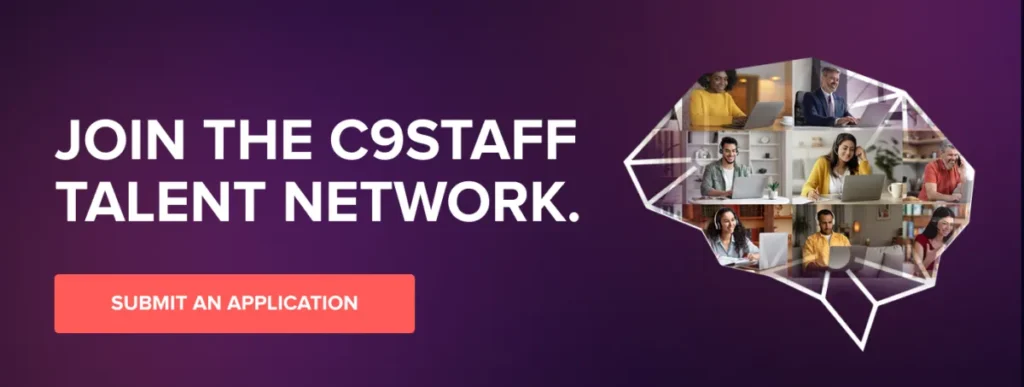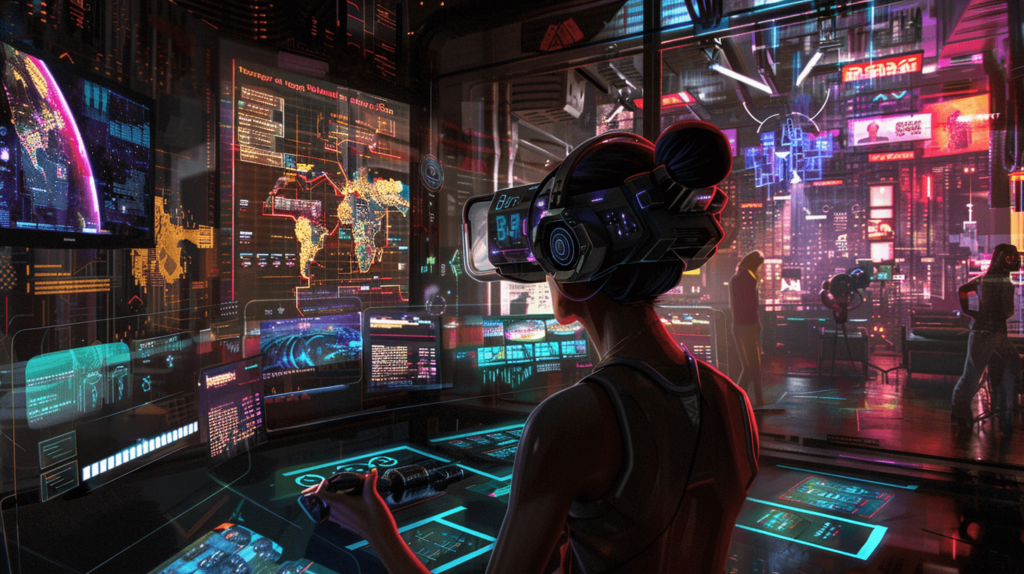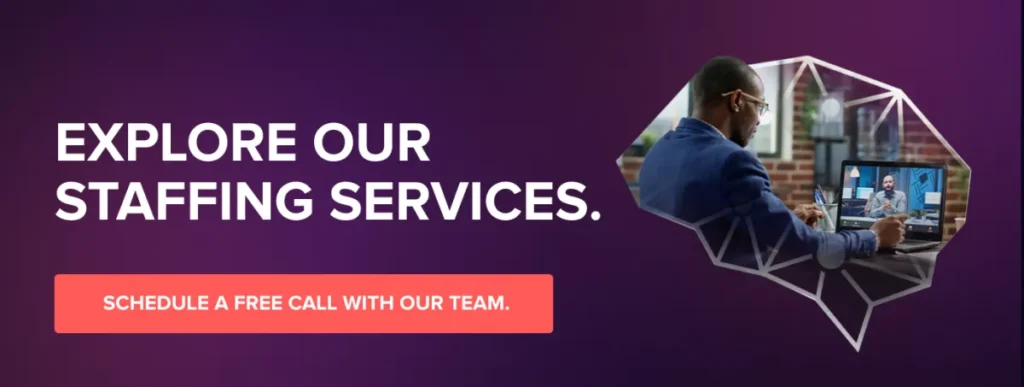Introduction

Picture you are at the forefront of your company’s digital evolution, a key player tasked with a mission crucial to the dynamic landscape of modern business. You need to hire a multimedia specialist—a pivotal figure who will drive your brand’s visual and auditory presence, elevating your company’s message across myriad platforms and capturing the imagination of audiences worldwide.
If your goal is to find the ultimate job description template for a multimedia specialist—one that you can use as a robust foundation for your own hiring needs—look no further. By clicking the link below, you will gain access to a complimentary job description template that embodies the fundamental principles and best practices of C9Staff’s renowned hiring methodology. This meticulously crafted document is designed to help you attract the top talent necessary to drive your organization’s success in the digital realm. Don’t miss out on this opportunity to elevate your hiring process with our expertly developed template.
Multimedia Specialist Job Description Template

In today’s fast-paced, digital-first world, multimedia specialists stand as central figures. Their role? To blend creativity with technical prowess, harnessing tools and technologies that transform plain concepts into captivating multimedia experiences. Whether it’s crafting stunning graphics, producing compelling videos, or developing interactive web experiences, the job of a multimedia specialist is both varied and vital. They not only engage current trends but also set new ones, making their mark with every project they touch.
You, whether an employer eager to harness such talent, a job seeker aspiring to imprint your creativity in this thriving field, or an educator molding the next wave of multimedia experts, are invited to delve deeper. This guide is designed for you to explore the intricacies of crafting the perfect multimedia specialist job description—one that attracts, challenges, and fulfills the creative and technical aspirations of tomorrow’s leaders.
Board on this journey with us, as we unfold the layers that constitute a stellar multimedia specialist’s role. Let this guide empower you to sculpt a job description that not only meets the evolving demands of the digital age but also enhances your strategic objectives, ensuring your company stands out in the bustling digital marketplace.
Understanding the Multimedia Specialist Role

Dive into the diverse world of a multimedia specialist and uncover the layers that make this role indispensable in various industries. As you navigate through the complexities of modern business landscapes, consider the critical blend of artistry and technical expertise that these professionals embody. From creating engaging advertisements to designing interactive educational courses, multimedia specialists leverage their unique skills to connect with audiences on multiple sensory levels.
This role is pivotal across sectors such as marketing, education, entertainment, and corporate communications. Imagine the range of projects a multimedia specialist might handle: crafting animated graphics for a new product launch, producing video content that tells a company’s story, or building user-friendly websites that serve as the digital face of a brand. Each project not only demands a deep understanding of visual design and technological tools but also a strategic approach to communicating messages effectively.
Now, let’s outline the key responsibilities and typical day-to-day tasks of a multimedia specialist. Your day might start with a meeting to discuss the vision for a new marketing campaign, followed by hours meticulously designing digital elements that align with this vision. Or perhaps, you are debugging the code of a newly developed website to ensure optimal user experience. These professionals bring concepts to life through digital art, video production, and web design—every day offers a new challenge and a new opportunity to influence how a brand is perceived.
Consider the profound impact of multimedia specialists on business success and project outcomes. For instance, a well-executed digital campaign can significantly increase brand visibility and customer engagement, directly influencing sales and market presence. By highlighting case studies, like a multimedia campaign that boosted a startup’s recognition overnight or a training program that enhanced employee performance, we see the tangible benefits these specialists bring to their teams and projects.
As you read on, feel yourself becoming more involved and invested in understanding the full scope and significance of this dynamic role. The world of multimedia specialists is not just about creating beautiful content—it’s about crafting experiences that resonate, inform, and inspire. Whether you are an employer, a job seeker, or an educator, recognizing the value and impact of these professionals will enhance your approach to interacting with or becoming part of this vibrant field.
Essential Skills and Qualifications

Step into the shoes of a multimedia specialist and explore the essential skills and qualifications that set the foundation for success in this dynamic role. As you navigate the complex digital landscape, the ability to effectively use tools and technologies becomes crucial. Start by delving into the technical skills required for this role, particularly software proficiency. Mastery of Adobe Creative Suite, with its myriad capabilities from Photoshop for photo editing to After Effects for video production, is indispensable. Also, a strong grasp of graphic design principles and video editing techniques is essential. These skills allow you to produce compelling digital content that captures and retains audience attention.
Now, let’s transition to discussing the soft skills that are equally critical for a multimedia specialist. Creativity stands at the forefront, fueling the innovation needed to conceptualize and realize visually striking projects. Communication, too, is vital; it ensures that your ideas align with client expectations and that your visions are understood and appreciated by all stakeholders. Teamwork cannot be overlooked either, as multimedia projects often require a collaborative effort across various departments. Picture yourself coordinating with marketers, designers, and IT specialists, each collaboration pushing the project toward its successful completion.
To illustrate, imagine leading a project to launch a new product. Your technical skills enable you to design eye-catching promotional materials, while your communication and teamwork skills ensure the project aligns with the strategic goals of the marketing and sales teams. This synergy not only enhances the project’s outcome but also bolsters your reputation as a capable leader in multimedia settings.
Finally, examine the educational pathways and professional certifications that enhance a multimedia specialist’s candidacy. Degrees in multimedia design, digital media, or similar fields provide a structured learning environment to develop both your artistic flair and technical acumen. Additionally, certifications in specific software, like Adobe Certified Expert (ACE), can distinguish you in a competitive job market.
As you read this, whether you’re an aspiring multimedia specialist assessing your career path or an employer delineating what to look for in potential hires, consider these insights as your guide. This exploration is not just about fulfilling job requirements; it’s about weaving your passion and proficiency into a career that thrives on creativity and innovation.
Crafting the Perfect Job Description for Employers

Imagine you are an employer poised to attract top talent for a multimedia specialist role within your organization. This crucial task begins with understanding and effectively communicating the scope and significance of this role through a compelling job description that resonates with the ideal candidates.
Choosing the Right Job Title and Writing an Engaging Summary Start by selecting a job title that accurately reflects the responsibilities and level of expertise required. Avoid generic titles; opt for one that specifies the role’s focus, such as “Senior Multimedia Designer” or “Interactive Media Specialist.” Craft an engaging summary that highlights the role’s importance in your organization. Explain how this position contributes to your overall business objectives and digital presence, making it clear why this role is pivotal.
Detailing Responsibilities Progress to delineating the detailed responsibilities expected of the position. Incorporate both broad objectives and specific tasks. For instance, you might list responsibilities such as “Develop multimedia content for brand campaigns,” “Coordinate with marketing to ensure alignment with broader advertising goals,” and “Manage and execute video projects from concept through completion.” Ensure that these responsibilities convey the scope of work and the impact of the role within your company.
Qualifications and Skills Next, describe the necessary qualifications and desired skills. Emphasize both the technical skills—like proficiency in Adobe Creative Suite, HTML5, and CSS3—and the soft skills crucial for success in the role, such as creativity, problem-solving, and effective communication. Mention any educational requirements, such as a bachelor’s degree in Graphic Design, Multimedia Arts, or related fields, and professional certifications that could enhance candidacy.
Work Environment Discuss the work environment—be it remote, in-office, or hybrid—to set clear expectations. Clarify any flexible working arrangements or expectations for in-office collaboration, which can significantly influence a candidate’s decision to apply.
Company Culture and Values Highlight the importance of reflecting your company’s culture and values in the job description. This alignment helps ensure that the candidates who apply are those whose values resonate with your organizational ethos. Mention aspects like teamwork, innovation, and community involvement that are central to your company.
Making the Job Appealing Conclude with strategic tips on making the job description not only informative but also appealing. Use positive language and highlight unique benefits like career development programs, work-life balance initiatives, or cutting-edge project opportunities that make your company an attractive place to work.
If your goal is to find the ultimate job description template for a multimedia specialist—one that you can use as a robust foundation for your own hiring needs—look no further. By clicking the link below, you will gain access to a complimentary job description template that embodies the fundamental principles and best practices of C9Staff’s renowned hiring methodology. This meticulously crafted document is designed to help you attract the top talent necessary to drive your organization’s success in the digital realm. Don’t miss out on this opportunity to elevate your hiring process with our expertly developed template.
Multimedia Specialist Job Description Template

A Job Seeker’s Guide to Evaluating Multimedia Specialist Job Descriptions

Picture yourself in the thick of a job search, keen on landing a position as a multimedia specialist. You’re not just looking for any job; you’re searching for a role that fits like a glove with your skills, passions, and career aspirations. This section will guide you through the essential steps to effectively read and evaluate job descriptions, ensuring they align with your career path.
Understanding Job Descriptions Begin by learning how to dissect a job description. Each line holds key insights into what the employer values most. Start with the core responsibilities—these will tell you about the daily tasks you’ll be expected to perform and hint at the broader goals of the team or company. Notice the language used; is it more about innovation and creativity, or does it focus on maintenance and execution? This can indicate the company’s stage (e.g., growth phase vs. established phase).
Identifying Attractive Features What makes a job posting stand out? Look for clear advancement opportunities which show that the company invests in its employees’ growth. Highlights of company culture, such as team retreats, open communication policies, or strong diversity commitments, can signal a supportive and dynamic work environment. Competitive benefits like health insurance, pension plans, and bonuses are also important markers of a company that values its staff.
Spotting Red Flags Contrast these attractive features with potential red flags. Vague responsibilities can be a warning sign that the employer might not have a clear plan for your role. Unrealistic expectations—like requiring the skills of a senior specialist at an entry-level salary—can indicate a lack of understanding or respect for the profession. A lack of detail about the team or who you would report to might suggest organizational disarray.
Tailoring Your Application Next, provide practical tips on tailoring your resume and portfolio to meet the specific needs outlined in the job description. Highlight experiences and skills that resonate directly with the role. If the job emphasizes creativity and innovation, showcase your most creative projects or times when you’ve thought outside the box. Use keywords from the job description in your resume to pass through automated HR systems effectively.
Engage directly with these tips as if you are receiving one-on-one advice tailored to your job search journey. This personal touch will make the guidance more relatable and actionable. By scrutinizing job postings with a critical eye and tailoring your application materials effectively, you enhance your chances of securing a multimedia specialist role that not only meets your needs but also propels your career forward.
Are you ready to supercharge your career and land your dream job? C9Staff is here to help! Click the link below to submit your resume to our talent acquisition department. If your qualifications align with our client requirements, we’ll be in touch to explore potential opportunities that match your skills and aspirations. Don’t miss this chance to connect with top employers and take your career to the next level. Submit your resume today, and let C9Staff help you find the perfect fit!

Educators and Career Counselors: Guiding Aspiring Multimedia Specialists

Envision yourself as an educator or career counselor tasked with guiding the next generation of multimedia specialists. This crucial role involves not only imparting knowledge but also ensuring that your students are industry-ready upon stepping out of the classroom. This section will equip you with strategies to effectively use job descriptions as educational tools.
Using Job Descriptions as Curriculum Guides Begin by understanding how job descriptions can serve as a real-world curriculum guide. These documents are treasure troves of information, illustrating the skills and qualifications that the industry values most. As an educator, you can use these descriptions to craft lesson plans that align directly with what students will encounter in the workforce. For instance, if job listings frequently cite proficiency in specific software like Adobe After Effects or coding languages like JavaScript, these can form core components of your digital media courses.
Integrating Current Trends in Multimedia Education Next, delve into key trends in multimedia education. There is an increasing emphasis on digital storytelling and interactive content creation. Explore how these trends can be integrated into educational programs. For example, you might introduce modules that focus on virtual reality (VR) and augmented reality (AR), preparing students for the cutting-edge demands of modern multimedia roles. This integration ensures that your curriculum remains relevant and dynamic, mirroring the evolving landscape of the multimedia industry.
Career Pathways and Progression Discuss the various career pathways and progression opportunities available for students aspiring to become multimedia specialists. Outline potential entry-level roles, such as junior graphic designers or video editors, and explain how these can evolve into more senior positions like multimedia project managers or creative directors. Highlight the types of industries that frequently hire multimedia talents—ranging from advertising agencies and digital media firms to educational institutions and corporate marketing departments. This overview helps students visualize their potential career trajectory and understand the diverse opportunities that await them.
Actionable Insights for Implementation Address directly to you, the educators and career counselors, providing actionable insights and encouraging you to implement these strategies in your guidance efforts. For instance, encourage your students to follow industry job boards to understand employer expectations and to tailor their portfolios accordingly. Suggest they engage in internships and collaborative projects that provide hands-on experience with the tools and technologies prevalent in the industry.
This approach should empower you to prepare students not just for graduation, but for thriving careers in multimedia. By connecting educational goals with industry standards through practical, job-description-based curriculum enhancements, you are setting up your students for success in a competitive, ever-changing digital landscape.
The Future of Multimedia Specialist Roles

Visualize yourself as a futurist, peering through the lens of time to predict the evolution of multimedia specialist roles over the next 5-10 years. The landscape of digital content creation is continually morphing, and with it, the role of the multimedia specialist is rapidly evolving. This section will navigate through emerging trends and ground-breaking technologies that are currently shaping the future of this dynamic field.
Emerging Trends and Ground-breaking Technologies
Let’s start by exploring key innovations like augmented reality (AR), virtual reality (VR), and artificial intelligence (AI) in content creation. AR and VR are transforming the way we interact with digital content, creating immersive experiences that were once the realm of science fiction. AI is revolutionizing content creation by automating complex processes, from color correction to sound design, enabling multimedia specialists to focus on creativity and strategy. These technologies are expected to redefine the scope and application of multimedia expertise, expanding the horizons beyond traditional media into experiences that engage users in entirely new ways.
Predictions for Job Evolution As we move forward, consider how the job of a multimedia specialist might evolve, especially as multimedia content becomes increasingly integrated into non-traditional sectors like healthcare and education. In healthcare, multimedia specialists might create virtual simulations for surgical training or patient education. In education, the rise of e-learning platforms demands engaging content that enhances learning through interactivity and gamification. These sectors will require specialists who not only understand technical aspects of multimedia production but who are also adept at integrating educational and therapeutic objectives into their designs.
Changing Skill Sets and Job Responsibilities The required skill sets and job responsibilities are also expected to evolve. Multimedia specialists will need to become proficient in new software and technologies, such as 3D modeling tools and real-time animation software. They will also need to cultivate a deeper understanding of user experience design and behavioral psychology to create content that is not only visually appealing but also highly interactive and effective in achieving its intended purpose.
The Growing Importance of Multimedia Content Conclude by discussing the growing importance of multimedia content across industries. Its role in digital marketing, e-learning, and customer engagement is becoming more crucial as consumers and professionals alike seek richer, more engaging digital experiences. This trend underscores the necessity for businesses to invest in skilled multimedia specialists who can deliver compelling content that stands out in an increasingly crowded digital landscape.
As you read this, consider how these trends might impact your career or your business. Whether you’re a budding multimedia professional or a hiring manager, staying ahead of these trends will prepare you for the exciting changes that lie ahead in the multimedia field. Engage with these insights, envision the possibilities, and start preparing today to meet the challenges of tomorrow.
Are you looking to source, recruit, hire, train, manage, and deploy the ideal multimedia specialist for your organization? C9Staff invites you to click the link below to schedule a free exploratory call with one of our expert account managers today. During this call, we will carefully listen to your specific needs and provide endorsements for potential candidates at no cost. This is your opportunity to evaluate the best talent available at competitive prices, ensuring you find the perfect fit for your team. Don’t miss the chance to enhance your hiring strategy with C9Staff’s comprehensive support.

Conclusion: Harnessing the Power of a Strategic Job Description

Reflect on the journey you’ve just embarked upon through this comprehensive guide. We began by recognizing the critical role that multimedia specialists play in today’s digital-first world and proceeded to dissect what makes a multimedia specialist’s job both complex and essential. Understanding the intricacies of crafting a precise job description can significantly impact hiring the right talent and ensuring organizational success. Such meticulous attention to detail in these descriptions helps align the right individuals with the right roles, driving both personal and corporate achievements.
Now, let’s directly address you—employers, job seekers, and educators—and encourage you to leverage the insights and strategies outlined throughout this guide for your specific needs. If you are an employer, remember that a well-crafted job description is your first interaction with potential talent and your opportunity to attract the best. Job seekers, use this guide to understand what potential employers seek and how to tailor your applications to meet these expectations precisely. Educators, integrate the real-world requirements of job descriptions into your curricula to better prepare students for the challenges they will face in the multimedia field.
As we conclude, consider the dynamic field of multimedia, which continues to reshape the contours of our digital landscape. The role of multimedia specialists is becoming more crucial as industries pivot to more interactive and visually engaging content to meet consumer demands. This evolving landscape offers boundless opportunities, but also challenges that require constant learning and adaptation.
I urge you, no matter your role, to take the insights gained from this guide and apply them. Whether you’re drafting your next job description, tweaking your resume, or updating your course syllabus, let the knowledge you’ve acquired lead you to make informed, strategic decisions. Your actions today will shape the multimedia landscape of tomorrow. So, step forward with confidence, armed with the best practices from this guide, and make your mark in the ever-evolving world of multimedia.




